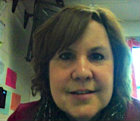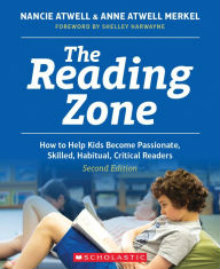Help Kids Read with Skill and Passion
The Reading Zone: How to Help Kids Become Passionate, Skilled, Habitual, Critical Readers, 2nd Edition
By Nancie Atwell and Anne Atwell Merkel
(Scholastic, 2016 – Learn more)

Reading Nancie Atwell and Anne Atwell Merkel’s cooperative endeavor is like getting a letter from a good friend and mentor. Atwell’s years of expertise in reading and writing are priceless to teachers, and I am so glad she is still writing to share her wisdom with the masses. (She was the first recipient of the Global Teacher Prize in 2015.)
This time her daughter is also on board as co-author, adding her own passion for reading and skill as a teacher to the mix.

The writing reads more like a novel than an instructional manual. Because of this, the evenings I spent reading The Reading Zone, I truly enjoyed every moment. It was like being a fly on the wall, peeking into classrooms to observe, gaining insight and learning how to be an expert teacher.
The “personal art” of reading
The first chapter describes the “personal art” of reading, a term borrowed from novelist Robertson Davies, and cites the reasons all students should be reading, including the academic benefits.
Atwell describes frequent, voluminous and self-selected reading as the cornerstone of reading workshop and the only way to teach children to be skilled, passionate, habitual and critical in their reading.
CTL teaches comprehension only in the setting of reading that is meaningful. All other skills, such as decoding and strategy work, are embedded in this teaching also. A student’s independent reading level and enjoyable books are key to teaching comprehension successfully.
Through a look at a particularly reluctant reader, the authors reveal how a teacher at CTL was able to create a love of pleasure reading through “booktalks.” Atwell also briefly addresses what they are not doing at her school (quizzes, note-taking, reading logs, book reports, etc.), and how reading workshop with personal pleasure reading of narrative text creates genuine readers.
Recognizing “the reading zone”
Next, Atwell delves into what a student called “the reading zone.” The label has remained at the school as a way to describe a reader being so wrapped up in his or her reading that s/he feels truly inside that world of story.
Through many student quotes, the zone is described. The chapter also examines the conditions necessary to enter that zone for children (drawing on student surveys). The top student responses highlight booktalks and mini-lessons, a classroom full of book choices, quiet time to read daily in class, free choice of genres and authors, book recommendations, comfort during reading time, writing about reading, individual conferences with the teacher about reading, keeping a list of books to read, and nightly reading as homework.
Another topic Atwell addresses is the significance of student choice in reading selections. As a foundation for choice, Atwell uses Daniel Penac’s Reader’s Bill of Rights (1992). Readers have the right to not read a book, to skip pages, to leave a book unfinished, to reread, to read anything, to fall into escapism, to read anywhere, to browse, to read out loud, and to not feel obligated to defend their tastes.
Starting the school year
On the very first day of school, Markel asks her students to fill out a survey about reading and inquires as to the types of books they may like. These surveys are the basis for the next few weeks of booktalks and conferences. Merkel and the other teachers at CTL also spend significant time and resources building a classroom library that all readers will enjoy and find enticing, as well as creating, “Books We Love” displays. Teachers will be able to begin reading workshop from the ground up after reading this chapter.
The next few chapters detail home reading as homework, how to make reading simple by showing readers their optimum levels, how to conference with students, and how to teach students to write about their reading to aid comprehension. These topics are the usual fare for teachers of English Language Arts, but Atwell and Merkel build a foundation for this understanding and provide evidence for why these tried and true strategies work.
Poetry for close reading and more
Daily poetry is how Merkel teaches close reading and involves her students in deep discussions that promote thinking. This is also where mini-lessons come into play to address grammar, structure, word choice, mood, tone, and vocabulary study, as well as reading strategies.
As a teacher, I felt like this would be the part of reading workshop where I would need the most support. I am intrigued by the idea of using poetry to teach almost every skill my students need to know. Atwell does have an older guide on the market that would probably help teachers get a more in-depth look at this part of the workshop.
The how and why of daily reading
The remaining topics the book delves into are the nonfiction genres, high school education, and practical ways to implement the strategies discussed in The Reading Zone. Although this book was a very quick and enjoyable read, it is packed with information that would help new and veteran teachers alike.
Despite the helpful array of topics this book covers, I will admit that I would still like to have more information. For example, take me through a typical day at CTL or give me suggestions for poems at each grade level that I can use. The book leaves me wanting more.
I would encourage future readers to check out the suggested resources at “Inside The Reading Zone” located at www.scholastic.com/RZresources [pw endeavor] for a more in-depth look at what the reading zone looks like in a classroom.
Ultimately, though, this book rewards the reader. While the simple act of reading daily has long been understood to be the best way to become a better reader, this book tells us the why and how.
Amy Matthes has been teaching for 19 years in Mansfield City Schools in Mansfield, Ohio. She spent 18 years teaching 1st grade and recently transitioned to 7th grade English Language Arts. As an elementary teacher, she had extensive training in the Literacy Collaborative, a reading and writing framework developed by Fountas and Pinnell and The Ohio State University. This background prompted the change to middle school, where the Literacy Collaborative is just being introduced and put into practice, and where she can call on her love of literature and writing. Matthes enjoys reading middle grade and young adult fiction as well as spending time with her family.

































